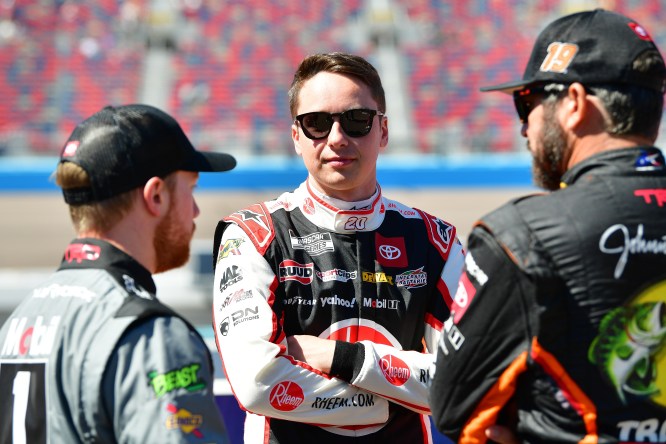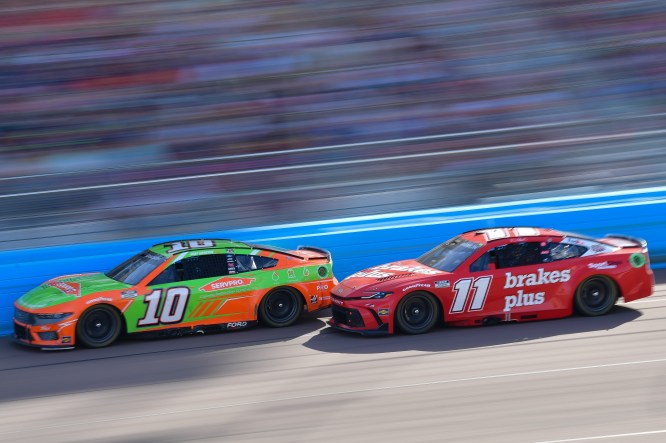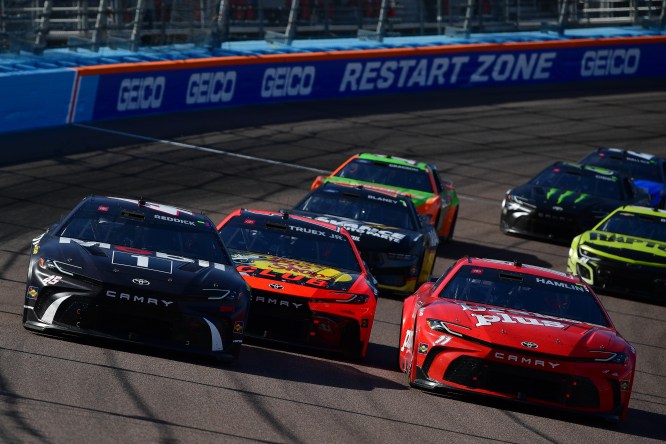
Christopher Bell is really intense.
Anyone who knows him will tell you, when he is at the track, Bell is the definition of ‘switched on kill,’ dirt car vernacular for ‘locked in’ and ‘focused’ on the task at hand.
So, it was rewarding to see the other side of Bell on Sunday after winning the Shriners Children 500 at Phoenix Raceway where ever so briefly he lets his guard down and lets loose before the next wave of intensity begins in advance of Bristol this weekend.
This was a legitimately wholesome exchange between Bell and FOX Sports NASCAR mainstay Bob Pockrass, the latter whom generally always gets first question rights in the media center as a reflection of his tenure and status.
But his race picks every week are also a figurative kiss of death and that was the focus on the lighthearted exchange.
‘Bob Pockrass, FOX Sports’
‘Christopher Bell, NASCAR driver … Bob, did you pick me today?’
‘No, I didn’t.’
‘Bob’s picks are notoriously the worst. If he picks me, I don’t win.’
‘I picked you last week.’
‘Well, I sucked.’ (laugh)
Again, it was just a lighthearted moment from a racer who doesn’t frequently loosen up at the track, and he owns his intensity too.
Bell lost a brake rotor in the championship race at Phoenix in November. He is coming off two disappointing results at Atlanta and Las Vegas. How could he not be wearing that a little.
“No, I was not angry,” Bell said. “I was just sad. Yeah, I don’t know. I suck at, like, trying to stay upbeat after a run of bad races. Atlanta was furthest from my fault, but it’s still a 34th or whatever place finish. We had a 33rd-place finish last week.
“I was pretty sad. I try not to let that affect my driving.”
Then came Friday and a car that showed a lot speed, both short run and long run, and then Bell started to feel like he could settle in and be in a really good place come Sunday. He was, as he drove from 13th to the lead before a bad pit stop dropped him to 10th.
If you’ve watched the Netflix documentary, NASCAR Full Speed, you know Bell has a bit of a chip on his shoulder about the perception of himself as a driver and his team. He has done nothing but when multiple races the past two years and appears poised to do it again.
It probably won’t change the intensity that pushes him forward but Bell hopes the perception is shifting and that maybe a second season of Full Speed will have him firmly in their plans.
“I just hope that this gives a little bit more insight to the world the capability that the 20 team has,” Bell said. “I feel like the last two years through the Next Gen era, myself and everyone inside of our team have seen glimpses of the potential but haven’t really been able to live it to fruition yet.
“I mean, I say this a lot, and the rest is up to us to make it happen, but I feel like this is just the beginning. Making the Final 4 and winning one or two races a year, that’s not our final goal. We don’t want to be a one- or two-win team a year. We want to be the championship contender year after year, multiple race wins year after year.”
Well, he hopes the perception is turning around for everyone who isn’t Bob Pockrass.
“Thank you, guys,” Bell said as he stood up to leave the media center on Sunday. “Don’t pick me next week, Bob.”
Championship implications?

For the second week in a row, and the second ‘real race’ in a row, it would be easy to make bold proclamations about how both Christopher Bell and Toyota raised their stock in advance of the Championship Race here in November.
There is some validity towards doing so because Ryan Blaney finished fourth, second and second in NextGen races at Phoenix before winning the championship in 2023. Combined with Joey Logano winning the championship in 2022, there were reasons to believe the championship would run through some combination of Ford, Team Penske or Blaney.
David Wilson, the president of Toyota Racing Development, said there were few reasons to make such declarations about his manufacturer before Bell’s dominant victory on Sunday.
“I was clear to say at the beginning of the year that we have struggled here recently,” Wilson said during the post-race press conference. “I didn’t realize this statistic until it was brought to my attention, but the four previous Phoenix races, Toyota’s led a combined 15 laps.
“Today we led everything but 16 laps or 14 laps. That’s a credit to the Joe Gibbs organization, TRD USA, Calty Design, who helped us with this new Camry body.”
Wilson called it a ‘momentous’ victory.
That’s because it’s easy to dismiss this as a one-off victory, or a small sample size of data for the new short track package, or a race in which Ford and Toyota are both still unlocking the maximum potential from their new body styles.
Tyler Reddick in a Legacy Motor Club Toyota was also right there with Bell on Speed.
“We were definitely, definitely better this week,” Stevens said. “But everything is so new, new tire combination. We were fortunate enough to be part of that test in December. It’s a new aero package for the field. A new body for Toyota. There’s just a lot of new in there. It took a lot different setup to really get the balance back.”
On the other hand, short of maybe Richmond, there isn’t a lot that carries over to Phoenix. There will not be real world opportunities to shake down a car at Phoenix until championship weekend in November.
“It’s definitely going to apply when we come back in November, no question,” Stevens said. “We have the best notebook to build off of. All of our teammates had moments of being really good. Not just the Toyotas, everybody’s got a list of how they can be better.
“It’s too early to tell if there is some kind of gap to the field. I don’t think that. I don’t feel that. I just think that we hit it better than everybody else did today.”
Bell just has to get back to the final four, which by the way, he remains the only driver to have clinched a championship opportunity in both years of the NextGen era.
He’s also already locked into the playoff a month into the season. That means a great deal.
Package Talk

“I don’t think the car is perfect for short track racing but I do think the product today was better than last fall at Phoenix.”
Brad Keselowski
It’s a completely reasonable approach to feel like NASCAR made an incremental gain this weekend at Phoenix for its short track rules package without declaring it an overall success.
Just like last year’s incremental improvement, each adjustment is not about reaching a binary outcome of success or failure, but instead is about directional positivity or negativity.
It’s true that the rules package created more rear instability, which saw the drivers slide around the track more, which paired with a slightly softer tire resulted in rubber being laid across the race track and providing another half a groove to race on.
This isn’t the long-term answer either.
“I would say that there was an improvement there. You have to ask some of the other competitors really to get a better feel for that, but I thought when we had a run, we could get close, closer than we could, and we could make a move.
The other thing I liked was the tire and the track conditions and the reduced downforce overall kind of widened the racetrack out a little bit. You could run two-wide on both ends of the racetrack. You could pass high if you had to, pass low if you needed to. It was just overall racier, I would say.”
Adam Stevens
List: The all-time consecutive seasons with at least one win
By Richmond standards, and that is absolutely a factor in having this conversation, it was a fine race. Sure, Bell stunk it up over the final third but even that stint saw strategic deviation forced by the timing of the final caution.
There were drivers on no tires, two tires and four tires.
It’s also fair to say that the only drivers that could really complete passes on Sunday were in Toyotas, who also appeared to have separated themselves from the other two manufacturers through this first short track race of the year.
But ultimately, Phoenix isn’t the best place to evaluate whether this package made real gains or not. Richmond won’t be either. Let’s revisit this after Martinsville because there are seasons where NASCAR has had great short track rules packages and not banner races at Richmond and Phoenix but did at Martinsville.
When the package is right, Martinsville will always deliver.
More than likely, this package is still a good bit off where NASCAR and the community will want it to be. The car is still too heavy without enough horsepower. The revs have been choked down to where drivers are encouraged to downshift on corner exit and the car still makes too much grip with its wider tires and stops too easily with its big IMSA style brakes.
These are probably things that will ultimately need to be addressed, but its development is going to cost teams money at a time where they are currently locked into a dispute with the sanctioning body over the next charter and revenue split package.
Further, the development of new tires and wheels, or even the brakes, would have to start next season with the start of a new contractual agreement with all the single source supplier contractors. The initial agreement to supply all the parts to the NextGen car runs through the 2024 season.
So for now, these are the only levers NASCAR can pull, short of a slight horsepower increase, which Denny Hamlin once again advocated for on Saturday.
He said one phone call could be made to all three engine manufacturers to switch over to the 750 horsepower tapered spacer, up from the 670 spacer used right now, and it wouldn’t change engine durability or cost but it would create another incremental improvement.
“It is hard to pass because we are all in the gas so much,” Hamlin said. “You have to get us out of the gas, whether through the tire or the horsepower. That combination is what makes passing so difficult.
“The more you can get us out of the gas, which means if we have more horsepower, we have to let off sooner, that gives us the opportunity to overtake for the cars behind. Fifty horsepower, while it may not be a game changer, any horsepower gain will be an advantage for passing.”
He also doesn’t understand why they won’t try it.
“I’ve been in the sport for 20 years now. I’ve been a part of all of these tests where we’ve squeezed it down, squeezed it down and every time we’ve squeezed it down, we would go in the building during the tests and say, that’s harder to pass – every time we’ve done that,” Hamlin said.
“I don’t understand – there is obviously other reasons. They are trying to get other manufacturers in here and do this or do that. There is a bigger picture that I won’t understand, you won’t understand. No one will ever understand, but we don’t need to sacrifice our actual product for trying to entice someone new.
“I think if you put on good racing, people will want to come, no matter what. We are going to continue to beat this horse until it finally gets some movement, but I don’t know if it will happen just because for reasons that we will never understand and will never get explained.”
Other takeaways

Noah Gragson finished 12th after running top-10 all race and would have finished there had he not landed on the wrong side of a coin flip strategy decision. But still, these are two downforce races in a row in which he has raced near the front of the field and looked like a threat to score a considerable amount of points and at least challenge for top-5s. He lost 35 points due to the technical infraction from Atlanta Motor Speedway but his 15.8 average finish might be good enough to get him back in the playoff conversation if he, crew chief Drew Blickensderfer and Stewart-Haas Racing are really starting to hit on something. He’s already back up to 26th in the standings
Stewart-Haas Racing in general showed a lot of promise in the first short track race of the year with Chase Briscoe scoring a top-10 and Ryan Preece running up front at times too.
Michael McDowell has a Cup Series leading 6.0 average starting position and already has two top-10 finishes this year. Front Row Motorsports seems to be making the most of its alliance with Team Penske and Ford with McDowell finishing P8 on Sunday and teammate Todd Gilliland finishing 17th and leading 14 laps. It’s becoming less of a surprise when McDowell especially challenges for top-10s and more of an expectation alongside the conviction that he should challenge for wins on road courses and superspeedways too.
Ty Gibbs should win at least a race this year. It’s not just about how he has started this season but how its also a continuation of a second half surge in 2023 that nearly propelled him to the playoffs. It’s cliché but Gibbs has embodied the transition of learning how to run in the top-10, and then in the top-5 before breaking through for the first win. If Toyota and Gibbs are as stout as they look so far with the new bodies, Gibbs will capitalize on that and race for early playoff headlines this autumn.
Chevrolet, after being the class of the field with their old notebook at Las Vegas, had a dreadful Sunday in the desert. Ross Chastain was the only Chevy driver inside the top-12. The whole OEM has work to do in advance of Richmond and Martinsville a month from now.
Matt Weaver is a Motorsports Insider for Sportsnaut. Follow him on Twitter.


